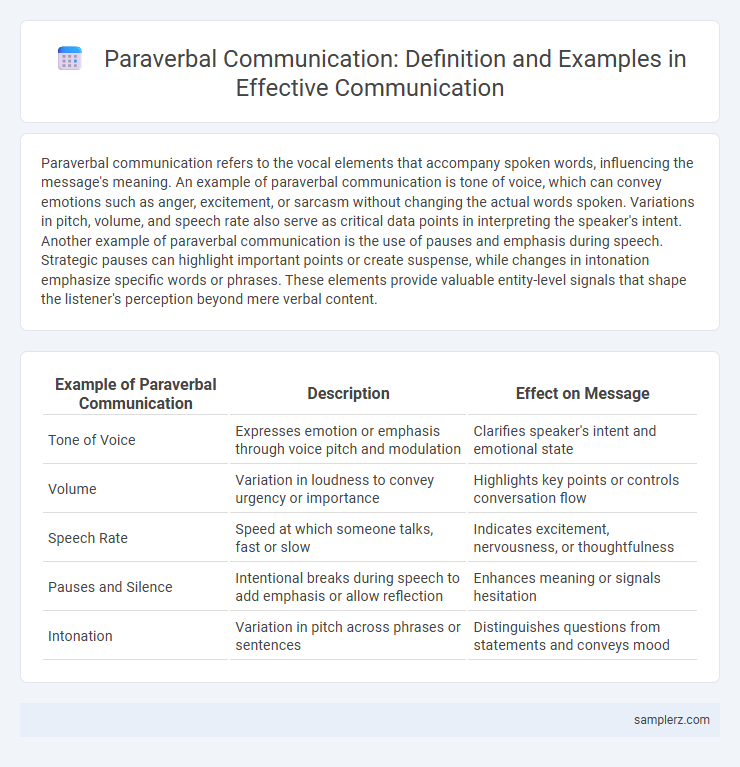Paraverbal communication refers to the vocal elements that accompany spoken words, influencing the message's meaning. An example of paraverbal communication is tone of voice, which can convey emotions such as anger, excitement, or sarcasm without changing the actual words spoken. Variations in pitch, volume, and speech rate also serve as critical data points in interpreting the speaker's intent. Another example of paraverbal communication is the use of pauses and emphasis during speech. Strategic pauses can highlight important points or create suspense, while changes in intonation emphasize specific words or phrases. These elements provide valuable entity-level signals that shape the listener's perception beyond mere verbal content.
Table of Comparison
| Example of Paraverbal Communication | Description | Effect on Message |
|---|---|---|
| Tone of Voice | Expresses emotion or emphasis through voice pitch and modulation | Clarifies speaker's intent and emotional state |
| Volume | Variation in loudness to convey urgency or importance | Highlights key points or controls conversation flow |
| Speech Rate | Speed at which someone talks, fast or slow | Indicates excitement, nervousness, or thoughtfulness |
| Pauses and Silence | Intentional breaks during speech to add emphasis or allow reflection | Enhances meaning or signals hesitation |
| Intonation | Variation in pitch across phrases or sentences | Distinguishes questions from statements and conveys mood |
Understanding Paraverbal Communication: Key Concepts
Paraverbal communication includes vocal elements such as tone, pitch, volume, and speech rate that convey meaning beyond the actual words spoken. Understanding paraverbal cues enhances the interpretation of emotions and intentions in conversations, improving interpersonal effectiveness. Effective communication relies on recognizing how variations in voice characteristics influence message perception and response.
Tone of Voice: Conveying Emotion and Intent
Tone of voice in communication significantly influences how messages are received by conveying emotions such as anger, joy, or sarcasm through variations in pitch, volume, and speed. For example, a softer, slower tone can indicate empathy and understanding, while a louder, faster tone may signal urgency or frustration. Mastery of paraverbal cues, especially tone of voice, enhances clarity and emotional connection between speaker and listener.
Speech Rate: Influence on Message Interpretation
Speech rate significantly impacts message interpretation by altering perceived urgency, confidence, and emotional state. Faster speech rates often convey excitement or impatience, while slower rates suggest careful thought or seriousness. Variations in speech rate enhance the paraverbal cues that shape listener understanding beyond the actual words spoken.
Volume Variations: Impact on Communication
Volume variations in paraverbal communication significantly affect message clarity and emotional tone, influencing how listeners perceive confidence, urgency, or aggression. Higher volume can convey strong emotions or commands, while softer speech often indicates intimacy, confidentiality, or hesitation. Effective control of volume enhances engagement and prevents misunderstandings in both personal and professional interactions.
Pauses and Silence: Adding Meaning Between Words
Pauses and silence in paraverbal communication serve as powerful tools to emphasize emotions, create suspense, or allow the listener time to process information. Strategic use of silence can convey confidence, hesitation, or thoughtfulness without spoken words. Effective communication leverages these pauses to enhance message clarity and emotional impact.
Intonation Patterns: Shaping Perception and Response
Intonation patterns in paraverbal communication critically influence how messages are perceived and responded to, with rising intonation often signaling questions or uncertainty, while falling intonation conveys confidence and finality. Variations in pitch, tone, and stress can alter the emotional meaning of spoken words, affecting listener engagement and interpretation. Effective control of intonation patterns enhances clarity, persuasion, and emotional connection in interpersonal communication contexts.
Emphasis and Stress: Highlighting Key Points
Emphasis and stress in paraverbal communication involve altering pitch, tone, and volume to highlight key points effectively. For example, raising vocal intensity on crucial words can draw attention and convey importance, enhancing message clarity. Strategic pauses combined with vocal stress create memorable and impactful communication moments.
Voice Quality: Affecting Listener Engagement
Voice quality, encompassing tone, pitch, and volume, significantly impacts listener engagement by conveying emotions and intentions beyond words. Variations in voice quality, such as a warm, enthusiastic tone, can foster trust and attention, while a monotone or harsh voice may lead to disengagement or misinterpretation. Effective communicators modulate voice quality to enhance message clarity and strengthen interpersonal connections.
Paraverbal Cues Across Different Cultures
Paraverbal cues such as tone, pitch, and speech rate vary significantly across cultures, influencing how messages are interpreted. For instance, a loud and fast-paced speech in Latin American cultures often conveys enthusiasm, whereas in East Asian cultures, a softer and slower tone may signal respect and thoughtfulness. Understanding these paraverbal differences enhances cross-cultural communication effectiveness and reduces misunderstandings.
Paraverbal Communication in Digital Interactions
Paraverbal communication in digital interactions includes elements such as tone of voice, pitch, and pacing conveyed through voice messages and video calls. These vocal cues enhance clarity and emotional expression, compensating for the absence of face-to-face nonverbal signals. Effective use of paraverbal features improves engagement and reduces misunderstandings in remote communication platforms.

example of paraverbal in communication Infographic
 samplerz.com
samplerz.com